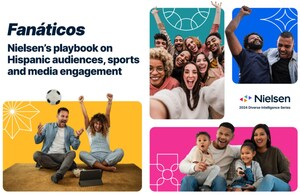In Scene, But Not Seen
On-screen representation increasing but so is cultural misrepresentation
NEW YORK, Dec. 9, 2021 /PRNewswire/ -- Diversity on-screen is at an all-time high across cable, broadcast, and streaming, platforms yet almost a quarter of viewers surveyed in 2021 indicate that representation is inaccurate according to Nielsen's latest Diverse Intelligence Series report titled Being Seen on Screen: The Importance of Quantity and Quality Representation on TV.
With 42.2% of the U.S. population racially and ethnically diverse today, the entertainment industry has an opportunity to create content that better portrays this diversity. Recent Nielsen data for the 2020-2021 TV season shows that among the top 1,500 programs, 78% have some presence of racial, ethnic, gender, or sexual orientation diversity.
"If you simply look at that high percentage point, you might think the majority of identity groups are well-covered. But lack of representation and diversity in popular content is more nuanced," says Stacie de Armas, SVP, Diverse Insights & Initiatives. "Looking back at the media moments this year, diverse casts and stories have been in the headlines. Yet, according to Nielsen's recent research, almost a quarter of people still feel that there is not enough content that adequately represents people from their identity group."
The report uncovers notable disparities in representation across all identity groups seen on cable, broadcast, and streaming platforms:
- Black talent is above on-screen parity, yet 58% of Black audiences say there's still not enough representation.
- Hispanic/Latinx broadcast Share of Screen appears close to parity at 22% with in-language programming being a key driver.
- South and Southeast Asian representation remain far below parity, compared to East Asian Share of Screen.
- Native American cultures are inaccurately represented or are missing altogether from America's most watched genres — such as drama, action adventure and reality.
In this report, Being Seen on Screen: The Importance of Quantity and Quality Representation on TV, Nielsen reports on key metrics across scripted, reality, variety, news and animated programming:
- Share of Screen (SOS): Provides the composition of the top 10 recurring cast members in a program
- Inclusion Opportunity Index (IOI): Compares the SOS of an identity group (e.g. women) to their representation in population estimates
The report is powered by Gracenote Inclusion Analytics, a solution delivering useful new metrics derived from Gracenote content metadata and Nielsen audience measurement data, providing the industry with consistent and reliable measurement of granular viewing. The report also leverages Gracenote Video Descriptors metadata relating to story, mood, character, theme, and scenario in each program.
REPORT HIGHLIGHTS
In order to capture a more holistic view of representation across media, Nielsen has expanded its dataset from the top 300 to the top 1,500 shows on broadcast, cable, and streaming platforms.
Black talent is above parity, but for Black audiences, parity is not enough. Representation is driven by the presence of Black men while Black women remain underrepresented
- Last season, the most representative dramas featuring Black women on screen averaged 15% Black women writers in their program credits. The difference in context for these inclusive programs is clear—more shows with Black women writers feature themes like justice, power, and glamour compared to how Black women are most often represented in themes such as competition and rivalry.
- 58% of Black audiences say there's still not enough representation.
Asian Pacific Islander American representation is not monolithic.
- East Asian representation is the only segment truly above parity on streaming at 2.8% in comparison to the population estimate of 2.1%
- South Asian SOS falls below parity, but when examined further South Asian males SOS is actually at parity at 2.3% while South Asian female SOS stands at just 0.3%.
Hispanic/Latinx programming is recognizing the inclusion of intersectional groups, such as Afro-Latinx, who over-index in genres such as Action/Adventure, Comedy, Music, Horror, and Reality.
- Hispanic/Latinx SOS skews heavily broadcast at 22.1%, compared to cable at 3.5% and SVOD at 8.5%. In-language programming is a key driver for Latinx/Hispanic broadcast, but as the population increasingly diversifies there is a need to broaden intersectional representation.
- More than 20 million Latinos identify as belonging to two or more races, a 567% increase from 2010.
Native American cultures are inaccurately represented or are missing altogether from America's most watched genres— such as drama, action adventure and reality.
- Native American SOS is highest on streaming platforms at 0.4%, but far below parity compared to the population estimate of 1.4%
- Native American SOS is less than 0.1% across broadcast and cable
LGBTQ+ community is seeking content more reflective of the lived experience.
- Stories featuring queer talent are increasingly highlighting authentic and meaningful narratives as evidenced by the top themes present: thoughtful, goodness, personal story, conflict, challenging situation, cerebral, performers, creative settings
- Cable had the highest representation of queer talent at 7.5%, followed by both broadcast and SVOD with less than 4% SOS
When specific identity groups see themselves represented at parity in content, these are the themes that are most present (based on Gracenote Video Descriptors - keywords capturing the story and context across mood, theme, scenario, and more in each program):
- Latinas: TV reporters, Athletes, Teammates, Victory, Nieces
- Black women: Uplift, Awareness, Family bonds, Competition, Friendship
- Black men: Referees, Political leaders, Determination, Ambition, Friendship
- EastAsians: Friends, Determination, Discovery, Risk, Courage
- South/Southeast Asian males: Wealthy people, Challenge, Cooks, Rivalry, Justice
- White women: Entertainers, Conscience, Morality, Honesty, Friendship
For more details and insights, download Being Seen on Screen: The Importance of Quantity and Quality Representation on TV. Please visit nielsen.com/inclusionanalytics to learn more. Join the discussion on Facebook (Nielsen Community) and follow us on Twitter (@NielsenKnows).
ABOUT NIELSEN
Nielsen shapes the world's media and content as a global leader in audience measurement, data and analytics. Through our understanding of people and their behaviors across all channels and platforms, we empower our clients with independent and actionable intelligence so they can connect and engage with their audiences—now and into the future.
An S&P 500 company, Nielsen (NYSE: NLSN) operates around the world in more than 55 countries. Learn more at www.nielsen.com or www.nielsen.com/investors and connect with us on social media.
SOURCE Nielsen
WANT YOUR COMPANY'S NEWS FEATURED ON PRNEWSWIRE.COM?
Newsrooms &
Influencers
Digital Media
Outlets
Journalists
Opted In






Share this article